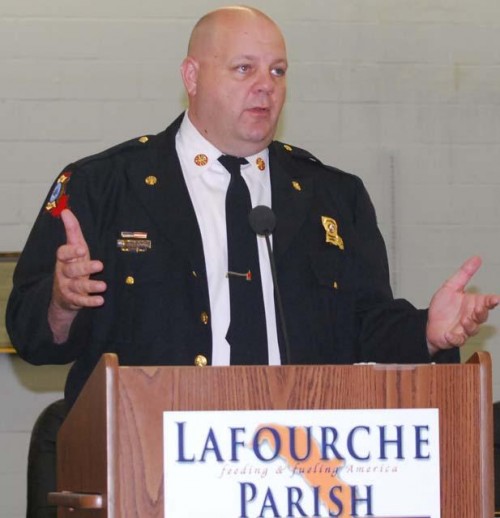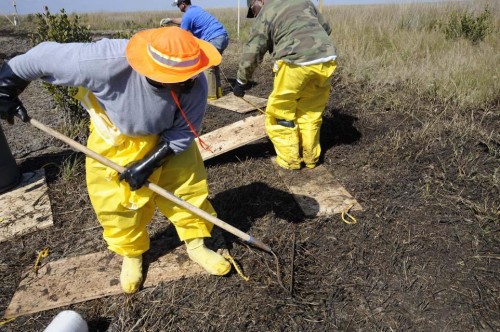
TGMC dedicates pictured wall of donors
April 19, 2011
Lafourche permit office tries to stymie
April 21, 2011One year ago today, 11 men were killed and 17 others were injured during a massive explosion at the BP Deepwater Horizon platform 40 miles off the coast of Louisiana.
Two days following that blast it was discovered that crude oil was being released from the broken rig site at a rate of 8,000 barrels per day.
Eventually both corporate and political bureaucratic delays were blamed for stalling responses as nearly 5 million barrels of oil gushed from the seafloor into the Gulf of Mexico and flowed with the tide toward land.
Oil coated the beaches, coastline marshes, vegetation and wildlife, while remaining underwater plumes laid in wait with scientists predicting they would surface at an unknown later date.
The BP oil spill was designated the worst environmental disaster in U.S. history before being completely capped on July 10, 2010.
In the weeks and months that followed the event of April 20, 2010, overall costs, excluding lives lost, mounted to more than what anyone could have expected.
Differing totals in the billions of dollars were estimated lost and projections were grim for the oil and gas industry, fisheries and local economies.
The tragedy mounted as an imposed federal drilling moratorium resulted in the shutdown of 33 deepwater rigs and immediately cut 13,000 oil production jobs.
In turn, work slowed for offshore suppliers, shipbuilders and the businesses where people in those industries spend their money including grocery stores and entertainment venues.
Fishing losses were estimated to be at $200 million by the end of 2010, and in turn families from that industry had no money to spend on goods and supplies in a manner they had done before the spill.
Tourism in Louisiana alone reported an estimated loss of $295 million, and professionals in that field blamed fears and an inflated perception of the extent of damage for keeping visitors living in other parts of the country away from the region.
Connections were also made between threatening health issues experienced by coastal residents and individuals working on recovery projects with a chemical dispersant used in cleanup efforts.
Twelve months removed from the event some industry insiders as well as environmentalists, already concerned about the deteriorating Louisiana coast, have agreed on one thing, lessons have been learned from the BP spill that might not have otherwise been addressed in the manner that they have.
Capt. Wayne Savoie is an experienced Houma-based tug boat operator and supply ship pilot. He readily claimed that the BP spill was more than a wakeup call to the oil and gas industry.
“Wow. What have we learned from this? We’ve learned so much. So much,” he said a few days prior to the oil spill anniversary.
Now working for Superior Energy Services, Savoie said in spite of any finger pointing, a lack of regulation enforcement and cutting corners to save money was at the center of the BP tragedy and has threatened oil production and other industries as well.
“A lot of things were skipped as far as these companies not following procedures of maintenance policies,” Savoie said. “It could have been avoided.”
Conflicting investigations offered differing views as to who or what was to blame for the Deepwater Horizon blast and oil spill. Yet, new drilling and workplace safety rules were implemented for the industry, and BP was used as the example for others to improve their own field operations.
“I am working with Superior Energy and we are getting ready to leave at the end of the year for Alaska for this Shell project in the Arctic,” Savoie said. “One [example used] in this project was the BP spill. My company is preparing a derrick barge to be oil spill prepared. This is in case a BP incident happens again. So I will be working to prevent [a spill] or respond to it.”
Savoie said one problem for BP and other producers, which he added should be corrected along with new regulations being followed and enforced, revolves around balancing maintenance and safety.
“It’s got to be together,” Savoie said. “If you’re just doing safety but not doing maintenance you are defeating the purpose. If you’re doing maintenance but not doing safety you are defeating the purpose.”
Lessons learned from the BP spill include the implementing of a new drilling safety rule that prescribes proper and regulated cementing and casting practices, and the appropriate use of drilling fluids to maintain bore integrity. This would be a first line of defense in case of a blowout.
Workplace safety is another area stressed after it was found that not only have oil companies cut corners in the past, but federal inspectors were being lax in their work as well.
One new safety rule requires offshore operators to identify potential hazards and clear programs before they begin drilling.
While some corporate petroleum insiders have the said added measures would cause delays and increase production costs, others contend that extra steps are worth the expense.
“There were a lot of things that were going on before the spill that we were dealing with and will continue to be dealing with,” Louisiana Wildlife Federation Coastal Outreach Coordinator Chris Macaluso said from his office in Baton Rouge.
Macaluso said that the oil spill only added to the damage of an already threatened area. It also brought national public awareness to Louisiana’s working coast and how the rerouting of the Mississippi River in the early 20th century, as well as the cutting of canals and lack of sediment from upstream, has harmed delta marshes, barrier islands and surrendered land to the encroaching Gulf of Mexico.
“During the oil spill we saw the consequence of having such a fractured coastline,” Macaluso said. “It led to it being more difficult to cleaning up oil that washed ashore in Louisiana compared to other Gulf States that have more solid beachfront coastlines.”
Environmentally, the oil spill alone put at risk more than 400 species of plants and 8,332 species of fish, birds, mollusks, crustaceans, sea turtles, and marine mammals along the U.S. coastal waters on the Gulf of Mexico.
However, Macaluso noted that he could think of surprising positives that came from the BP disaster. “Something that we are now taking advantage of in the wake of the oil spill is the continued effort to show people in other parts of the country just how bad our coastal land loss issues are,” he said.
Louisiana contains approximately 40 percent of all U.S. wetlands while it experiences 90 percent of coastal loss among all states. Additionally, 60 percent of Louisiana’s land loss takes place in Terrebonne and Lafourche parishes. With 70 percent of the Louisiana population living within 50 miles of the coast, a 2.7 mile wide strip of wetland being absorbed by the sea with nearly every hurricane threatens both local economies and an overall quality of life.
It is a concern, in addition to the oil spill, that Macaluso said only a tragic event seems to bring to public awareness.
The BP Deepwater Horizon explosion and oil spill will be long remembered and the damaging impact felt for decades to come. Yet those who believe in the people of the Gulf region contend they have not lost hope.
“It is sad we had to learn [all this] in a disaster,” Savoie said. “But it did help tighten up policies and procedures.”
“We are going to continue to monitor the effects of the oil spill for decades to come,” Macaluso said. “We will be seeing oil wash up in places on our coast for a very, very long time. But I think our wetland, to the surprise of some, has shown an amazing resilience despite the fact that they are washing away so quickly. It’s not an overnight process, [but] in some of the areas that were heavily oiled you can see shoots growing up in them.”
Repeated telephone messages left for BP Director of Government and Public Affairs Director Curtis Thomas, offering an opportunity to address lessons learned, were not returned as of press time.
Cleanup crews rake oiled marsh affected by the Deepwater Horizon oil spill at Bay Jimmy near Port Sulphur. The Bay Jimmy marsh cleanup operations began in February and mark ongoing efforts to rid the Gulf Coast of signs of oil. SEAMAN WILLIAM BENSON











